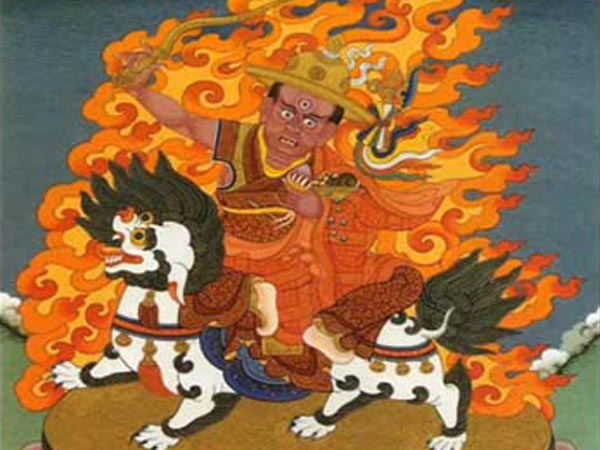DHARMA READINGS
| A GUIDE TO SPIRITUAL PRACTICE | | Print | |
 As the glorious Chandrakirti said:
- Pabongka Dorje Chang, Liberation in the Palm of Your Hand
Why Must I Practice?The greatest thing we can achieve in this life is to be able to liberate ourselves and others from suffering and its causes. To achieve that, we have to achieve the lam-rim, the gradual path to enlightenment through purifying all the negative karma we have collected and accumulate extensive merit.
What is Spiritual Practice?Spiritual practice is not something mystical that is separate from what we do as we go about our daily business. Often, people think that to be a spiritual person, one must leave the trappings of everyday life and embark on an epic journey to a faraway land in search of awakening. The truth is, spiritual practice can be incorporated into our daily lives. Many of these practices are readily available and establishing a consistent routine of study and practice ensures our progress along the spiritual path.
Relying on a Spiritual Guide The Guru is the root of the spiritual path and the foundation of all spiritual attainments, hence the importance of relying on a qualified Spiritual Guide. Just like carpenters and sculptors must first study with a teacher, spiritual aspirants also need to find a guru who is capable of guiding us along the spiritual path. Without receiving instructions and guidance from a qualified Spiritual Guide, one can never gain realizations or attainments. The Spiritual Guide helps us by giving us vows, empowerments and initiations, teaching us what is to be practised and what is to be avoided, and it is through the teacher that the blessings of the lineage flows. If you do not have a teacher, it would highly recommended that you search for one living in your area. If you don’t know where to start, this is a list of established lineage masters and spiritual guides and dharma centers that you may wish to consult: USA
Canada
Europe
For more reading on Spiritual Guides:
Studies and PracticesLama Tsongkapa presented a special arrangement of Sutra and Tantra practices which can lead one to full enlightenment in one short lifetime. Below is a summary of the core teachings, beginning with the Lamrim (Stages of the Path), following by Lojong (Training the Mind) and lastly Mahamudra (the actual quick path to enlightenment).
I. LAMRIM (Stages of the Path) The Lamrim (Stages of the Path) tradition presents a systematic, step-by-step cultivation of the Buddhist path to enlightenment from the point of view of three types of individuals. First it leads students through the stages of the two lower spiritual motivations – individuals who aspire for a better rebirth, and then those who aspire for individual liberation. It culminates in the presentation of the path for those practicing from the point of view of the highest spiritual motivation, the Mahayana – individuals who aspire to attain enlightenment for the benefit of all living beings. One studies the Lamrim to gain a panoramic understanding of the general teachings of the Buddha, and then receives the Lojong teachings in order to establish a quintessential regime of daily practice. For more detailed information on the Lamrim and how to meditate on it, these are some suggested reading materials:
II. LOJONG (Training the Mind) Lojong is a special formulation of the practical essence of the Lamrim teachings. Atisha embodied the pith of the Lojong teachings in his Lojong Tsa-tsig, and many of Atisha’s own Lojong teachings come to us only through passages found in the Book of the Kadampa Masters. Two Lojong texts most studied today across all schools of Tibetan Buddhism are Geshe Chekawa’s Seven Points for Training the Mind and Geshe Langri Tangpa’s Eight Verses for Training the Mind. For more detailed information on Lojong, these are some suggested reading materials:
III. MAHAMUDRA“Mahamudra” is a Sanskrit word meaning “great seal” and refers to the nature of all phenomena. It also refers to sophisticated Buddhist systems of meditation and practice to realise this great sealing nature. The distinctive characteristic of the Mahamudra method is the realization of the relationship between mind and reality through focusing on the mind itself. The Gelug tradition of Mahamudra is known as Gelug-Kagyu because it uses Kagyu-style methods for recognising the conventional nature of mind and then typically Gelug methods for its deepest nature. For more detailed information on Mahamudra, these are some suggested reading materials:
IV. PRELIMINARY PRACTICES The purpose of preliminary practices is to purify ourselves of the grossest level of obstacles and build up positive force so that our studies and meditations will be more efficacious in bringing us to enlightenment. Positive force or “merit,” refers to the conducive internal state that results from constructive, or “virtuous” actions of body, speech, mind and heart. The preliminary practices are sometimes enumerated as five or nine:
It is important to know that even the Mahamudra teachings also emphasize the importance and need for extensive preliminary practices. For more explanations on preliminary practices, these are some suggested reading materials:
V. GURU YOGA In order for realizations to ripen within our mind, we need to receive the Spiritual Guide’s blessings through the practice of Guru Yoga. Therefore, we should begin each preliminary practice with the particular guru yoga that we are able to do, such as the Six-Session Guru Yoga, the Guru Puja ( Lama Chöpa), the Guru Yoga of Lama Tsongkapa (Ganden Lha Gyäma) or the Guru Yogas of various deities for which we have received permission to practice. For more explanations on Guru Yoga, these are some suggested reading materials:
VI. RELYING ON THE DHARMA PROTECTOR DORJE SHUGDEN The principal function of a Dharma Protector is to protect Dharma teachings, lineages and practitioners. If one studies the nature and function of Dorje Shugden, one will develop great faith and clearly understand the benefits of relying upon this Dharma Protector. Dorje Shugden helps, guides, and protects pure and faithful practitioners by granting blessings, increasing wisdom, fulfilling wishes, and bestowing success on all virtuous activities. His powerful mandala and retinue are the synthesis of the Three Jewels – Buddha, Dharma and Sangha. Many sadhanas of Dorje Shugden state that Dorje Shugden is the embodiment of the ‘Guru, Yidam, and Protector’. For more explanations about relying on Dorje Shugden, these are some suggested reading materials:
|
OTHER DHARMA READINGS
- A GUIDE TO SPIRITUAL PRACTICE
- DHARMA DEMYSTIFIED: NAGARJUNA, THE FOUNDER OF THE MAHAYANA TRADITION
- DORJE SHUGDEN ON BLACK HORSE
- WHY MANJUSHRI MATTERS
- DHARMA DEMYSTIFIED: THE ENTHRONEMENT OF DORJE SHUGDEN









